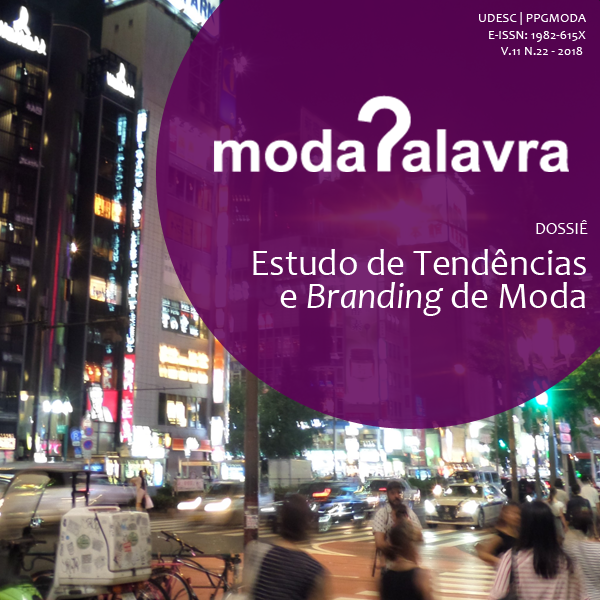Sobre o Estar-Junto-Com Como Tendência Sociocultural e Coletivos Criativos: uma proposta interdisciplinar de metodologia para identificação de tendências visando cenários de futuro
DOI:
https://doi.org/10.5965/1982615x11222018113Palavras-chave:
tendências socioculturais, coletivos criativos, economia criativa, cenários de futuroResumo
Esse artigo se debruça sobre uma proposta de metodologia de identificação de tendências socioculturais e seus desdobramentos. Para desenvolver tal objetivo, abordamos o entendimento de tendências especialmente a partir de uma visão sociológica. Ao abrirmos essa perspectiva, introduzimos nosso entendimento de que tendências socioculturais são sensibilidades sociais, e assim sendo, estabelecem os princípios para a emergência de formas sociais, valores e outras tendências. O entendimento dessa relação é essencial, pois nos leva a abordar a correspondência entre o objeto de estudo dessa investigação – os Coletivos Criativos – e a tendência sociocultural estar-junto-com. Tendo estabelecido as conexões entre essas instâncias, o trabalho aborda a imanente relação entre elas e a emergência da economia criativa, também tratada aqui como economia da cultura. Após tecer essas afinidades, apresentamos a ferramenta cenários de futuro e localizamos sua utilização na proposta metodológica que desdobramos. Tal proposta se pauta em princípios da sociologia compreensiva, da antropologia interpretativa e do Dialogismo, tendo nos cenários de futuro um mecanismo de visualização, por meio de narrativa, de desenvolvimento para elementos identificados in loco em Coletivos Criativos da cidade Porto Alegre.
Downloads
Referências
Referências Bibliográficas
BAKHTIN, Mikhail. Problemas na poética de Dostoiévski.4.ed. Rio de Janeiro: Forense Universitária, 2008.
BERGER, Peter. L., LUCKMANN, Thomas. A construção social da realidade.Petrópolis: Vozes, 2009.
BORDIEU, Pierre. O poder simbólico.11a. ed. Rio de Janeiro: Bertrand Brasil, 2007.
CALDAS, Dario. Observatório de sinais: teoria e prática da pesquisa de tendências.Rio de Janeiro: Editora Senac, 2004.
DE MASI, Domenico. Criatividade e grupos criativos: descoberta e invenção. Vol. 1. Rio de Janeiro: Sextante, 2003.
ECO, Umberto. Os limites da interpretação. 2 ed. São Paulo: Editora Perspectiva, 2012.
FLORIDA, Richard. A ascensão da classe criativa. Porto Alegre: L&PM Editores, 2011.
FOUCAULT, Michael. A ordem do discurso: aula inaugural no Collège de France, pronunciada em 2 de dezembro de 1970. 16.ed. São Paulo: Loyola: 2008.
FRANZATO, Carlo. et all. Inovação cultural e social: design estratégico e ecossistemas criativos. In FREIRE, Karine Mello (org) Design estratégico para inovação cultural e social. 1ed. São Paulo: Editora Kazuá, 2015.
GARNHAM, Nicholas. De las industrias culturales a las creativas. Análisis de las implicaciones en el Reino Unido. In BUSTAMENTE, Enrique. (org). Las Industrias Creativas: Amenazas sobre la cultura digital. 1 ed. Barcelona: Gedisa Editorial, 2011.
GEERTZ, Clifford. A interpretação das culturas. 1 ed.Rio de Janeiro: Zahar Editores, 2008.
MAFFESOLI, Michel. O conhecimento comum. São Paulo: Editora Brasiliense,1988.
______________. Mediações simbólicas: a imagem como vincula social. In: Revista Famecos, n. 8, pp. 7-14, jul. 1998.
______________. O tempo das tribos. 2002. 3.ed. Rio de Janeiro: Forense Universitária, 2002.
_____________. O tempo retorna: formas elementares da pós-modernidade. Rio De Janeiro, Forense, 2012.
MASSONNIER, Verónica. Tendencias de mercado: están pasando cosas. Buenos Aires: Ediciones Granica, 2008.
MORIN, Edgar. O método vol. 4.As ideias. vida, costumes. Porto Alegre: Sulina, 2011.
NIETZSCHE, Friederich. A origem da tragédia. São Paulo: Ed.Centauro, 2004.
REIMÃO, Sandra. Teoria ou teorias da comunicação.In: Revista INTERCOM, v. 17, nº 2. São Paulo, jul/dez. 1994.
REYES, Paulo Bello. Projeto por Cenários. In Design Estratégico em Ação. SCALETSKY, C. C. org. São Leopoldo: Editora Unisinos, 2016.
SIMMEL, Georg. Questões fundamentais da sociologia.Rio de Janeiro: Jorge Zahar, 2006.
TREMBLAY, Gaëtan. Desde la teoria de las industrias culturales.Evaluación critica de la economia de la creatividad.In: Bustamente, E. (org). Las industrias creativas: amenazas sobre la cultura digital. 1 ed. Barcelona: Gedisa Editorial, 2011.
YÚDICE, George. A conveniência da cultura. Usos da cultura na era global. Belo Horizonte: Editora UFMG, 2014.
Downloads
Publicado
Como Citar
Edição
Seção
Licença
Copyright (c) 2018 Paula Cristina Visoná

Este trabalho está licenciado sob uma licença Creative Commons Attribution-NonCommercial 4.0 International License.
Ao submeter um artigo para publicação no ModaPalavra e-periódico, o(s) autor(es) concorda(m) com os seguintes termos:
- Autores mantêm os direitos autorais e concedem à revista o direito de primeira publicação, com o trabalho simultaneamente licenciado sob a Creative Commons Atribuição-NãoComercial 4.0 Internacional, que permite o compartilhamento do trabalho com reconhecimento da autoria e publicação inicial nesta revista, sem pagamento;
- Os autores podem utilizar os mesmos resultados em outra publicações após a primeira publicação, desde que indiquem o ModaPalavra e-periódico como o meio de publicação original;
- Autores têm autorização para assumir contratos adicionais separadamente somente após a publicacão inicial no ModaPalavra e-periódico, desde que indiquem o ModaPalavra e-periódico como o meio de publicação original;
- Autores têm permissão e são estimulados a publicar e distribuir seu trabalho on-line (ex.: em repositórios institucionais ou na sua página pessoal), somente após o processo editorial e primeira publicação, desde que indiquem o ModaPalavra e-periódico como o meio de publicação original;
- Para indicar o ModaPalavra e-periódico como o meio de publicação original, o autor deve seguir texto modelo: "Este artigo foi publicado originalmente pelo ModaPalavra e-periódico, sob a licença CC BY NC, em seu volume [inserir volume], número [inserir número] no ano de [inserir ano], e pode ser acessado em: http://www.revistas.udesc.br/index.php/modapalavra/";
- As opiniões expressas nos artigos são de inteira responsabilidade dos autores, não refletindo necessariamente a opinião da revista. A publicação de artigos, fotos e desenhos foi autorizada previamente pelos responsáveis ou seus representantes para publicação no ModaPalavra e-periódico.









